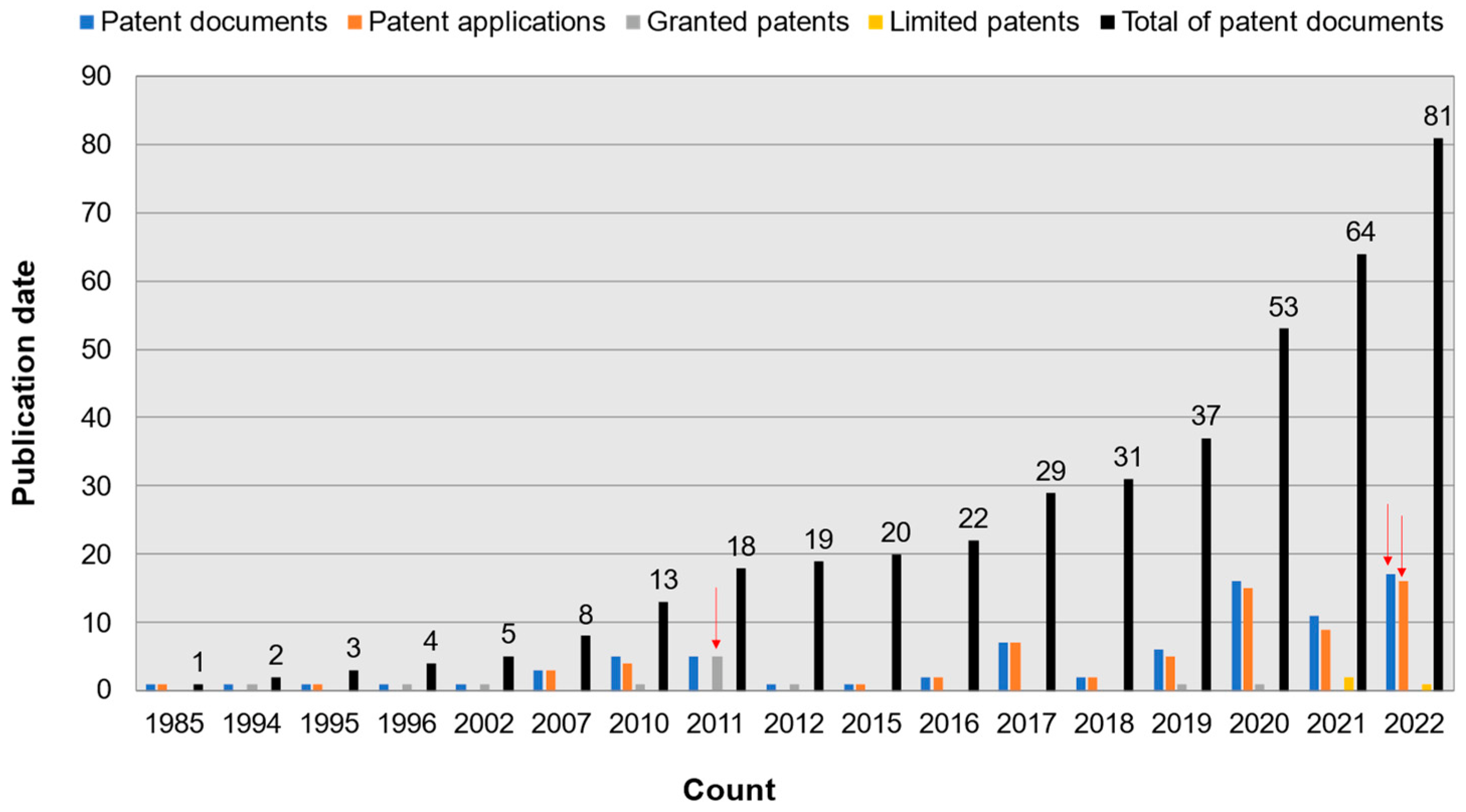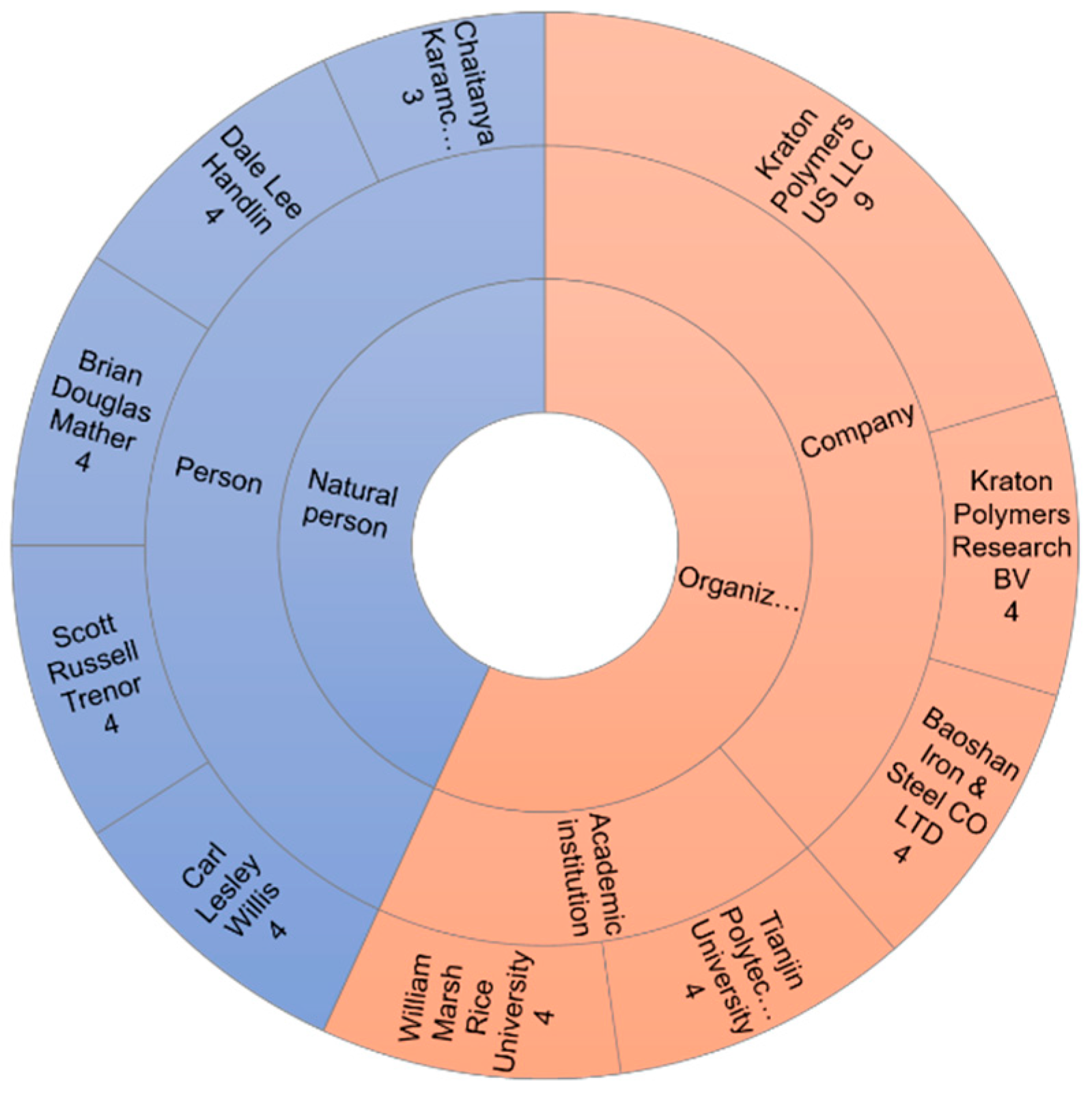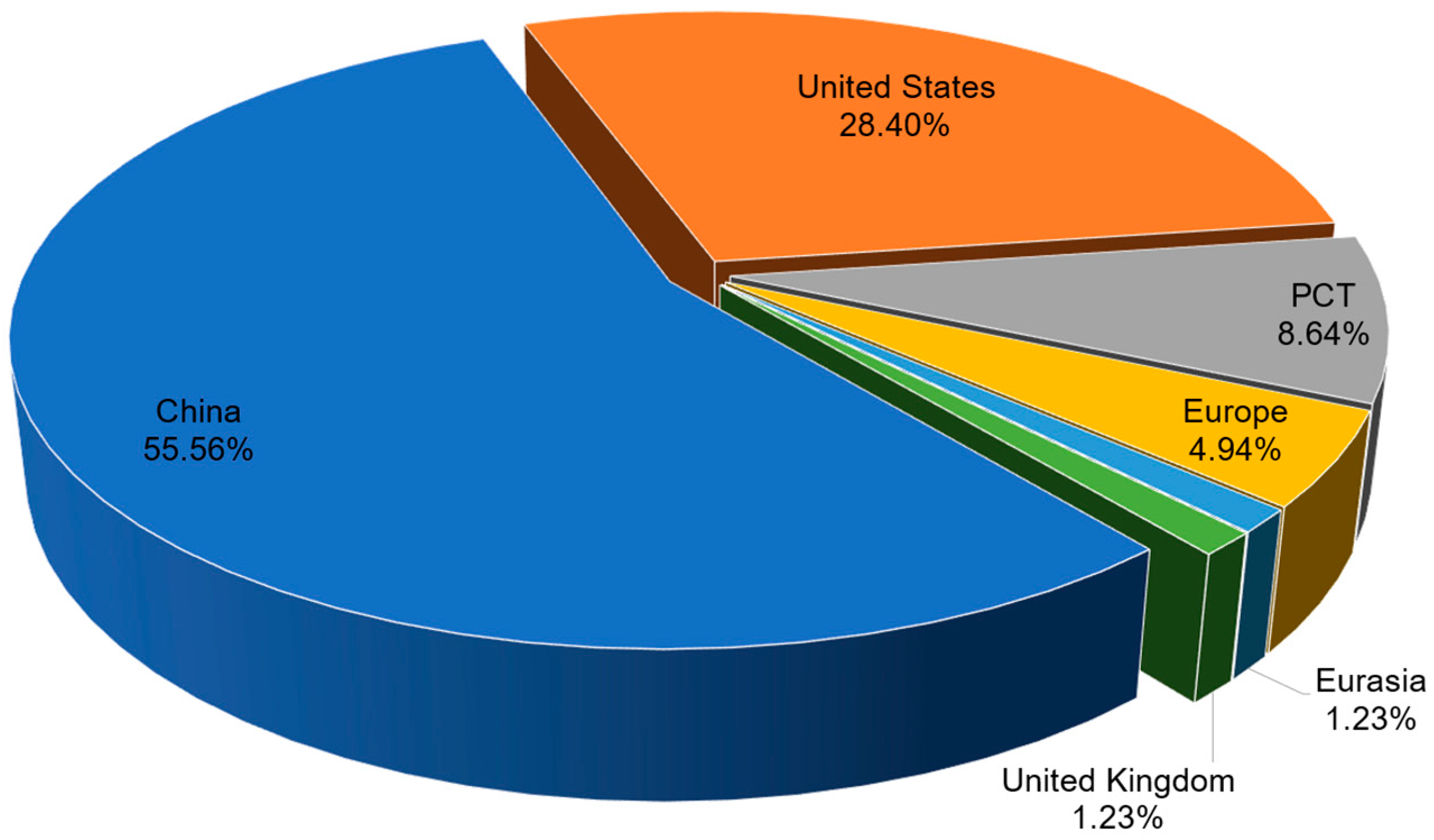Use of Hydrogels for Seawater Desalination Processes: A Patent Landscape Report †
Abstract
:1. Introduction
2. Methods
3. Results and Discussion
3.1. Documents Type and Patent Families
3.2. Publication Date of Patent Documents
3.3. Patent Applicants and Owners
3.4. Jurisdictions and Legal Status of Patents
- 40 patent documents are in force (i.e., active status);
- 30 pending applications (i.e., pending status);
- 6 withdrawn or rejected applications (i.e., discontinued status);
- 4 patents that have reached the term date and are no longer in force (i.e., expired status);
- 1 PCT application that has been granted in one or more designated countries (i.e., patented status).
3.5. Patent Classifications
4. Conclusions
Funding
Institutional Review Board Statement
Informed Consent Statement
Data Availability Statement
Acknowledgments
Conflicts of Interest
References
- Arfin, T. Current innovative chitosan-based water treatment of heavy metals: A sustainable approach. In Handbook of Biopolymers. In Handbook of Biopolymers: Advances and Multifaceted Applications; Shakeel, A., Suvardhan, K., Gopalakrishnan, K., Eds.; Jenny Stanford Publishing: New York, NY, USA, 2018; pp. 167–182. [Google Scholar]
- Elimelech, M.; Phillip, W.A. The Future of Seawater Desalination: Energy, Technology, and the Environment. Science 2011, 333, 712–717. [Google Scholar] [CrossRef] [PubMed]
- Hafiane, F.Z.; Fatimi, A. An emulsion-based formulation for increasing the resistance of plants to salinity stress: US20160302416A1 patent evaluation. Environ. Sci. Proc. 2022, 16, 4. [Google Scholar] [CrossRef]
- Ali, W.; Gebert, B.; Altinpinar, S.; Mayer-Gall, T.; Ulbricht, M.; Gutmann, J.S.; Graf, K. On the Potential of Using Dual-Function Hydrogels for Brackish Water Desalination. Polymers 2018, 10, 567. [Google Scholar] [CrossRef] [PubMed]
- Höpfner, J.; Richter, T.; Košovan, P.; Holm, C.; Wilhelm, M. Seawater Desalination via Hydrogels: Practical Realisation and First Coarse Grained Simulations. In Intelligent Hydrogels; Sadowski, G., Richtering, W., Eds.; Springer International Publishing: Cham, Switzerland, 2013; pp. 247–263. [Google Scholar]
- Fatimi, A. Chitosan-based embolizing hydrogel for the treatment of endoleaks after endovascular aneurysm repair. Int. J. Polym. Mater. Polym. Biomater. 2019, 68, 107–114. [Google Scholar] [CrossRef]
- Fatimi, A.; Okoro, O.V.; Podstawczyk, D.; Siminska-Stanny, J.; Shavandi, A. Natural hydrogel-based bio-Inks for 3D bioprinting in tissue engineering: A review. Gels 2022, 8, 179. [Google Scholar] [CrossRef] [PubMed]
- Akhramez, S.; Fatimi, A.; Okoro, O.V.; Hajiabbas, M.; Boussetta, A.; Moubarik, A.; Hafid, A.; Khouili, M.; Simińska-Stanny, J.; Brigode, C.; et al. The circular economy paradigm: Modification of bagasse-derived lignin as a precursor to sustainable hydrogel production. Sustainability 2022, 14, 8791. [Google Scholar] [CrossRef]
- Fatimi, A. Chitosan-based hydrogels: Patent analysis. Mater. Proc. 2022, 9, 1. [Google Scholar] [CrossRef]
- Fatimi, A. Trends and recent patents on cellulose-based biosensors. Eng. Proc. 2022, 16, 12. [Google Scholar] [CrossRef]
- Fatimi, A. Patentability of biopolymer-based hydrogels. Chem. Proc. 2022, 8, 39. [Google Scholar] [CrossRef]
- Fatimi, A. Hydrogel-based bioinks for three-dimensional bioprinting: Patent analysis. Mater. Proc. 2021, 7, 3. [Google Scholar] [CrossRef]
- Fatimi, A. A patent data analysis of the innovation trends in biological control agent formulations. Recent Adv. Food Nutr. Agric. 2022, 13, 59–69. [Google Scholar] [CrossRef] [PubMed]
- Fatimi, A. Cellulose-based hydrogels: Patent analysis. J. Res. Updates Polym. Sci. 2022, 11, 16–24. [Google Scholar] [CrossRef]
- Fatimi, A. Exploring the patent landscape and innovation of hydrogel-based bioinks used for 3D bioprinting. Recent Adv. Drug Deliv. Formul. 2022, 16, 145–163. [Google Scholar] [CrossRef] [PubMed]
- Fatimi, A. Seaweed-based biofertilizers: A patent analysis. Recent Pat. Biotechnol. 2022, 16, 144–154. [Google Scholar] [CrossRef] [PubMed]
- Cambia Institute. The Lens Patent Data Set. Version 8.7.0. Available online: www.lens.org (accessed on 4 December 2022).
- Gould, F.E.; Johnston, C.W. Hydrophilic Polyurethane Acrylate Compositions. UK Patent GB2150938A, 10 July 1985. [Google Scholar]



| Owners | Type (Headsquare) | Count |
|---|---|---|
| Baoshan Iron & Steel CO LTD | Company (Shanghai, China) | 2 |
| Kraton Polymers US LLC | Company (Houston, TX, USA) | 2 |
| City University of Hong Kong | Academic institution (Kowloon Tong, Hong Kong) | 1 |
| Lockheed Martin Corporation | Company (Bethesda, MD, USA) | 1 |
| Saudi Basic Industries Corporation | Company (Riyadh, Saudi Arabia) | 1 |
| South China University of Technology | Academic institution (Guangzhou, China) | 1 |
| William Marsh Rice University | Academic institution (Houston, TX, USA) | 1 |
| Zhejiang University | Academic institution (Hangzhou, China) | 1 |
| IPC | Description | Count |
|---|---|---|
| C02F103/08 | Treatment of seawater (e.g., desalination) | 29 |
| C02F1/14 | Treatment of water by distillation or evaporation using solar energy | 21 |
| B01D67/00 | Processes specially adapted for manufacturing semi-permeable membranes for separation processes or apparatus | 14 |
| C02F1/44 | Treatment of water by dialysis, osmosis, or reverse osmosis | 12 |
| B01J13/00 | Colloid chemistry (e.g., the production of colloidal materials or their solutions) | 10 |
| C08J3/075 | Treatment or compounding of macromolecular substances, such as macromolecular gels | 10 |
| B01J20/26 | Organic material, such as synthetic macromolecular compounds to make solid sorbent compositions or filter aid compositions sorbents for chromatography processes | 9 |
| C02F1/04 | Treatment of water by distillation or evaporation using solar energy | 8 |
| C02F1/00 | Treatment of water, waste water, or sewage | 7 |
| C02F1/28 | Treatment of water by sorption using ion-exchange sorbent compositions | 6 |
Disclaimer/Publisher’s Note: The statements, opinions and data contained in all publications are solely those of the individual author(s) and contributor(s) and not of MDPI and/or the editor(s). MDPI and/or the editor(s) disclaim responsibility for any injury to people or property resulting from any ideas, methods, instructions or products referred to in the content. |
© 2023 by the author. Licensee MDPI, Basel, Switzerland. This article is an open access article distributed under the terms and conditions of the Creative Commons Attribution (CC BY) license (https://creativecommons.org/licenses/by/4.0/).
Share and Cite
Fatimi, A. Use of Hydrogels for Seawater Desalination Processes: A Patent Landscape Report. Environ. Sci. Proc. 2023, 25, 11. https://doi.org/10.3390/ECWS-7-14184
Fatimi A. Use of Hydrogels for Seawater Desalination Processes: A Patent Landscape Report. Environmental Sciences Proceedings. 2023; 25(1):11. https://doi.org/10.3390/ECWS-7-14184
Chicago/Turabian StyleFatimi, Ahmed. 2023. "Use of Hydrogels for Seawater Desalination Processes: A Patent Landscape Report" Environmental Sciences Proceedings 25, no. 1: 11. https://doi.org/10.3390/ECWS-7-14184
APA StyleFatimi, A. (2023). Use of Hydrogels for Seawater Desalination Processes: A Patent Landscape Report. Environmental Sciences Proceedings, 25(1), 11. https://doi.org/10.3390/ECWS-7-14184






